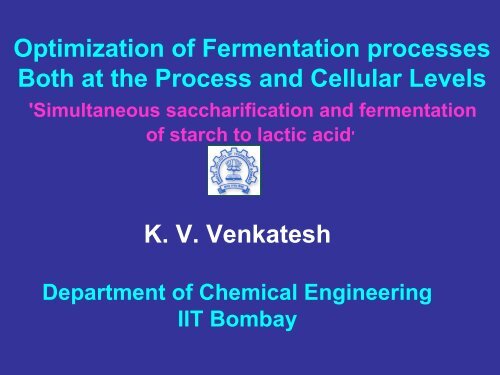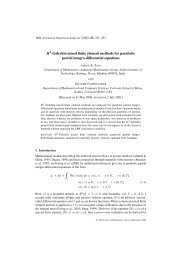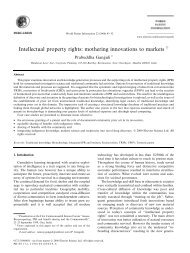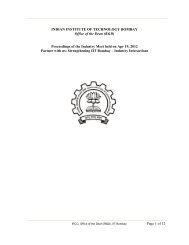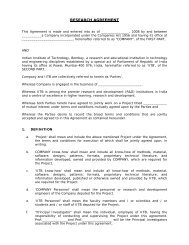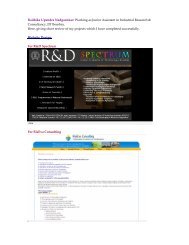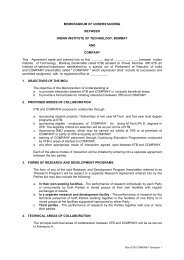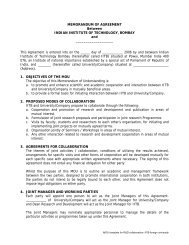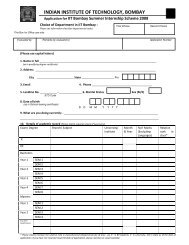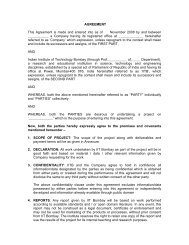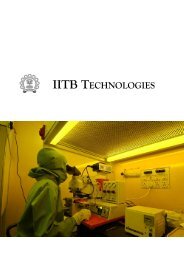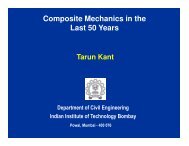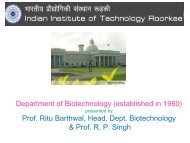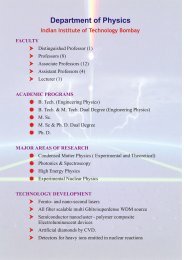Simultaneous saccharification and fermentation of starch to ... - IRCC
Simultaneous saccharification and fermentation of starch to ... - IRCC
Simultaneous saccharification and fermentation of starch to ... - IRCC
Create successful ePaper yourself
Turn your PDF publications into a flip-book with our unique Google optimized e-Paper software.
Optimization <strong>of</strong> Fermentation processes<br />
Both at the Process <strong>and</strong> Cellular Levels<br />
'<strong>Simultaneous</strong> <strong>saccharification</strong> <strong>and</strong> <strong>fermentation</strong><br />
<strong>of</strong> <strong>starch</strong> <strong>to</strong> lactic acid'<br />
K. V. Venkatesh<br />
Department <strong>of</strong> Chemical Engineering<br />
IIT Bombay
Introduction<br />
• Living cells can be used <strong>to</strong> produce biochemical products<br />
• Natural screening <strong>of</strong> the environment <strong>to</strong> isolate<br />
microorganisms<br />
• Isolated microorganisms or cells as pure cultures are<br />
grown in bioreac<strong>to</strong>r – <strong>fermentation</strong> processes<br />
• Fermentation processes are used <strong>to</strong> produce chemicals<br />
ranging from food, polymer, pharmaceuticals, bulk<br />
chemicals, bio-energy, waste management etc
Metabolism<br />
Cell<br />
Substrate<br />
Multiple Enzymatic<br />
Reactions<br />
Products<br />
1. Diverse products can be produced by various living cells<br />
2. Diversity depends on the metabolism evolved in a<br />
particular organism; Yeast – ethanol, Lac<strong>to</strong>bacillus – Milk<br />
<strong>to</strong> yogurt etc
Fermentation Process<br />
• Cells/Microorganisms require a medium for its<br />
growth<br />
• Medium typically contains a carbon, nitrogen<br />
<strong>and</strong> essential nutrients<br />
• Optimal pH <strong>and</strong> temperature<br />
• Optimization at the process level: Media,<br />
environmental conditions<br />
• Operation – batch, fed-batch or continuous
Starch as a carbon Source<br />
• Starch is a polysaccharide <strong>of</strong> glucose<br />
molecules<br />
• Enzymatic hydrolysis <strong>to</strong> glucose<br />
Inhibits<br />
Alpha - amylase Gluco-amylase<br />
Starch Dextrin Glucose<br />
Rate <strong>of</strong> the enzymatic process<br />
is reduced due <strong>to</strong> glucose inhibition
Lactic acid <strong>fermentation</strong><br />
• Lac<strong>to</strong>bacillus strain converts glucose <strong>to</strong><br />
lactic acid<br />
Glucose<br />
Glycolysis<br />
Lactic Acid<br />
Starch<br />
Glycolysis<br />
Lactic acid
Inhibition <strong>of</strong> Saccharification by<br />
fermentative products<br />
• Lactic acid<br />
• Ethanol<br />
Lactic Acid<br />
• Butanol<br />
• Diacetyl<br />
Dextrin<br />
Gluco-amylase<br />
Glucose<br />
• Ace<strong>to</strong>in<br />
• Citric acid<br />
The above products <strong>of</strong>fer lesser inhibition than<br />
glucose
<strong>Simultaneous</strong> Saccharification <strong>and</strong><br />
<strong>fermentation</strong><br />
Gluco-amylase<br />
Dextrin<br />
Glucose<br />
Glycolysis<br />
Lactic Acid<br />
Enzymatic reaction <strong>and</strong> <strong>fermentation</strong> in the same reac<strong>to</strong>r<br />
will not allow the accumulation <strong>of</strong> glucose <strong>to</strong><br />
inhibit the <strong>saccharification</strong> step
Strategy<br />
• Detailed modeling <strong>and</strong> experimental analysis <strong>of</strong><br />
the <strong>saccharification</strong> step<br />
• Detailed modeling <strong>and</strong> experimental analysis <strong>of</strong><br />
the <strong>fermentation</strong> step<br />
• Prediction <strong>of</strong> optimal condition for SSF using<br />
model<br />
• Temperature (45C), pH (5.5) <strong>and</strong> glucose<br />
concentration (< 20 g/L) crucial for the operation<br />
<strong>of</strong> SSF<br />
• Experimental verification <strong>to</strong> demonstrate<br />
increased rates <strong>and</strong> productivities<br />
• Fed-batch operation for reducing product<br />
inhibition
Cellular Optimization<br />
• Cells screened from nature are typically<br />
optimized for growth<br />
• Cells are the micro-reac<strong>to</strong>rs in the<br />
<strong>fermentation</strong> process<br />
• The main step for economical process is <strong>to</strong><br />
perform cellular optimization.<br />
• Metabolic <strong>and</strong> genetic engineering can be<br />
used <strong>to</strong> alter the cellular behaviour.<br />
• Directed mutation versus r<strong>and</strong>om mutation.
Metabolic Network analysis<br />
1. Determine the limiting step in the<br />
Metabolism<br />
2.Quantification <strong>of</strong> feasible metabolic space<br />
3. Removal <strong>of</strong> the limiting step in the<br />
network.<br />
4.Detailed Kinetics <strong>of</strong> the process using<br />
metabolism.<br />
5. Elementary mode analysis
What are the elementary modes ?<br />
An elementary mode is a minimal subset <strong>of</strong><br />
enzymes in a network that can operate at steady<br />
state with all irreversible reactions proceeding in<br />
the direction as prescribed by thermodynamics.<br />
Elementary mode analysis links network structure<br />
<strong>to</strong> flux balance (evaluation <strong>of</strong> reaction rates)
Methodology: Hypothetical Network<br />
System chosen<br />
Elementary modes<br />
Kalyan Gayen <strong>and</strong> K. V Venkatesh ESBES -2006
Rates <strong>of</strong> external metabolites<br />
Problem formulation<br />
Linear programming formulation<br />
In matrix form<br />
Experimentally<br />
Determined<br />
(known)<br />
Kalyan Gayen <strong>and</strong> K. V Venkatesh ESBES -2006, Austria
Biochemical<br />
Network <strong>of</strong><br />
Corynebacterium<br />
glutamicum<br />
Metabolites : 39<br />
Reactions: 40<br />
Substrates: Glucose, ammonia<br />
<strong>and</strong> oxygen<br />
Products: Lysine, Biomass,<br />
Trehalose <strong>and</strong> Carbon dioxide
Elementary Modes for the network <strong>of</strong> C. glutamicum
Elementary modes<br />
operational in<br />
Corynebacterium<br />
glutamicum<br />
Fourteen elementary<br />
modes<br />
Maximum biomass (124)<br />
Maximum Lysine (63.5)<br />
Kalyan Gayen <strong>and</strong> K. V Venkatesh<br />
BMC Bioinformatics, 2006
Flux distribution map <strong>of</strong> C. glutamicum<br />
for lysine production<br />
Optimal<br />
Biomass
Conclusions<br />
• Two level Optimization <strong>of</strong> <strong>fermentation</strong><br />
processes – reac<strong>to</strong>r <strong>and</strong> cellular<br />
• Reac<strong>to</strong>r: Engineering approaches - SSF, fedbatch<br />
operation, in situ separation etc<br />
• SSF concept has been used for conversion <strong>of</strong><br />
cellulose <strong>to</strong> bi<strong>of</strong>uels<br />
• Cellular: Metabolic Engineering<br />
• Quantification <strong>of</strong> biological processes is a key<br />
step in such an application
Acknowledgement<br />
1. Pr<strong>of</strong>. A. K. Suresh<br />
2. Dr. Anuradha Raghunathan (Scientist, NCL)<br />
3. DST for funding
Thank<br />
you !


